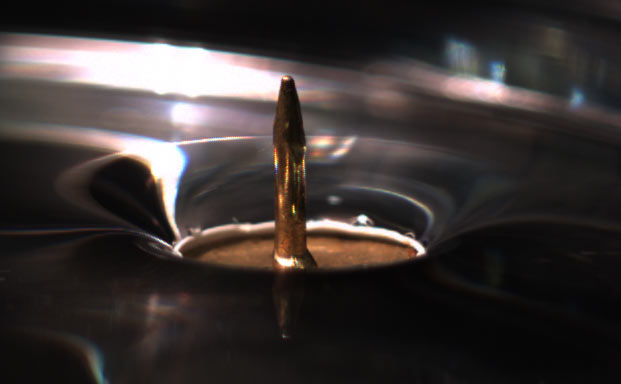Research: The 'Cheerios effect'
Have you ever noticed how Cheerios (and other light breakfast cereal) seem to aggregate to form clumps when they float on the milk in your breakfast bowl? This is an effect due to the surface tension between the milk and the air: the air-milk interface does not like to be deformed (just like an elastic sheet resists deformation) but at the same time, gravity is pulling on the individual Cheerios. At some deformation of the interface, the two effects cancel so that we have a deformed interface and the single object is in equilibrium. This balance can be illustrated quite dramatically by floating a single drawing pin on water, as shown below.
 |
Figure 1: A single drawing pin floating on water illustrating the balance between surface tension and the weight of the floating object. This picture was described as the `phenomenal anti-intuitively floating-upside-down thumbtack' by the blog of the Annals of Improbable Research. |
This is not the end of the story, however, since the other cheerios can feel that the interface is tilted by the presence of the first and so tend to fall down the interface - towards the first cheerios. This explains the aggregation that you might have noticed in your breakfast bowl, and works equally well for all sorts of particles floating at interfaces; the bubbles in a glass of champagne (sparkling water) all seem to clump together and then stick to the walls of your glass for precisely the same reason.
For alternative summaries of this, you might like to check out some
of the things that various science based websites have written about this:
Physics News
Update
Improbable Research - what's new
livescience.com
MSNBC
Harvard
Crimson
wissenschaft.de
Something in Russian
The Anglia News video (70 MB)
A short description following "Bild der Woche" in die Zeit
Alternatively, you might like to read the "still no cure for cancer" discussion this sparked on fark.com
Reference:
D. Vella and L. Mahadevan, "The 'Cheerios effect'", Am. J. Phys. 73, 814 (2005). PDF File (176 KB)
Copyright notice Copyright (2005) American Association of Physics Teachers. This article may be downloaded for personal use only. Any other use requires prior permission of the author and the American Association of Physics Teachers. This article appeared in Am. J. Phys. 73, 814 (2005) and may be found here.
Abstract:
Objects that float at the interface between a liquid and a gas interact because of interfacial deformation and the effect of gravity. We highlight the crucial role of buoyancy in this interaction, which, for small particles, prevails over the capillary suction that is often assumed to be the dominant effect. We emphasize this point using a simple classroom demonstration, and then derive the physical conditions leading to mutual attraction or repulsion. We also quantify the force of interaction in some particular instances and present a simple dynamical model of this interaction. The results obtained from this model are then validated by comparison to experimental results for the mutual attraction of two identical spherical particles. We conclude by looking at some of the applications of the effect that can be found in the natural and manmade worlds.
Back to research interests.
Back to index.